
Why Today is Math Geeks’ Favorite Friday the 13th in a Century
A rare occurrence that could have been predicted a thousand years ago
August 13, 2021
Well, hello there! It’s been a while. A lot has happened since we’ve seen each other, and we have a mid-game (ish) recap coming your way next week. But today, let’s take a moment to celebrate a rare moment of true mathematical predictability written by Harvard Economist Scott Kominers. In a world filled with uncertainty, it’s nice to know we’ll have something to look forward to in the year 2102. We’ll see you next week with more from The Prediction Game!
For most people, Friday the 13th conjures images of bad luck and cheesy horror films. But in the math circles I run in, this particular Friday the 13th presents a rare and “golden” opportunity.
The date, 8-13-21, combines three adjacent numbers in the Fibonacci sequence – a renowned mathematical progression obtained by starting with 1 and 1, and then successively adding the prior two numbers to get the next one:
1, 1, 2, 3, 5, 8, 13, 21, 34, 55, 89, 144, 233, 377, 610, 987, 1597…
It’s not often we see dates that line up with this sequence. The last time this happened was May 8th, 2013, and I guess if you’re willing to stretch, then you could claim May 5th, 1989 as a candidate (55, 89). But I think we’d all agree after scanning the numbers above that dates like today are few and far between.
But, really though, why do my math geek friends and I derive so much glee from days like today?
It’s delightful to spot mathematics in everyday life. And Fibonacci numbers are especially intriguing. They show up in nature – in the spirals of pineapples, sunflowers, and pinecones, and even (possibly) in the mating patterns of bees and rabbits. They have applications in finance. And moreover, the ratios of consecutive Fibonacci numbers converge to the golden ratio, a mathematical constant that appears in art and architecture – not to mention a classic Donald Duck cartoon.
Plus, mathematically, the Fibonacci numbers have many surprising and beautiful properties. For example, the sum of the squares of the first N Fibonacci numbers equals the product of the N-th and the (N+1)-st. There’s even a way to represent all integers in terms of Fibonacci numbers, as an alternative to our standard base-10 number system.
Plus while the Fibonacci numbers start small, they get big quickly. The sequence has exponential growth, just like compound interest or a nuclear reaction. One consequence of that is that while there were several Fibonacci days at the start of the century, they get further and further apart. The last one, as previously noted, was 5-8-13. And unless you count January 21, 2035 as “13-21-34,” we won’t see another Fibonacci day like this until 2102.
But never fear! If we look at the dates a bit differently, there’s a Fibonacci day coming up in about a year and a half: 1-1-23. And I’m hoping to be around for 11-23-58, when the date will string together all six of the single-digit Fibonacci numbers at once.
But for now, let’s savor the moment. Grab some pineapple, sunflowers, or honey — or just hug your pet rabbit! Try out this recipe for Fibonacci lemonade. Or stay up late – you can maybe pass the time by watching a scary math movie – and when it’s five seconds past 11:23 pm, you can toast 11:23:05 8-13-21.
Find Out What
Comes Next in Tech.
Start your free trial.
New ideas to help you build the future—in your inbox, every day. Trusted by over 75,000 readers.
SubscribeAlready have an account? Sign in
What's included?
-
Unlimited access to our daily essays by Dan Shipper, Evan Armstrong, and a roster of the best tech writers on the internet
-
Full access to an archive of hundreds of in-depth articles
-
-
Priority access and subscriber-only discounts to courses, events, and more
-
Ad-free experience
-
Access to our Discord community


Comments
Don't have an account? Sign up!